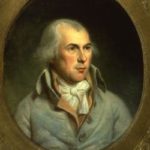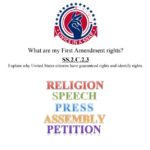The First Amendment Academy is a hub for quick, engaging quizzes from Freedom Forum, which also provides educational resources through NewseumED. The quizzes test middle school and high school students’ knowledge with real-world scenarios, interactive activities and thought-provoking questions that make learning these five fundamental freedoms fun, fast and relevant.
George Washington and the Pursuit of Religious Freedom
George Washington and the Pursuit of Religious Freedom is based on a 15-minute film that covers religion in early America, the defeat of the British Empire, and the steps leading up to the passing of the Bill of Rights in 1791. Accompanying resources, such as an interactive map and an interactive timeline investigate the history of religion in early America, Washington’s interactions with various religious groups, and his role in securing religious freedom. Teacher resources include graphic organizers, vocabulary sheets, and additional information to guide inquiry.
Balancing Religious Freedom and Government Interests
This lesson explores the Supreme Court case Tandon v. Newsom (2021) regarding religious liberty.Throughout the COVID-19 pandemic, the state government of California along with many of its county governments placed restrictions on gatherings of people. One of their regulations had the effect of preventing more than three households gathering together at a time for any in-home prayer and Bible studies. Plaintiffs sued the state, arguing that these restrictions violated the First Amendment since many secular businesses were allowed to have more than three households of people within it at any time, and that therefore religion was being specifically discriminated against. The Supreme Court recently released a per curiam (unsigned) decision concerning the constitutionality of these regulations.
Freedom of Religion: Free Exercise Clause
Students will examine the protections enshrined in the First Amendment’s Free Exercise Clause. Students will use the Interactive Constitution to examine the Free Exercise Clause’s text and history and how the Supreme Court has interpreted it over time. In this lesson, students compare and contrast the questions, opinions, and dissents in a series of Supreme Court cases to define when the Free Exercise Clause does and does not limit government action.
Free Speech Essentials
Do your students know what they’re free to say online? At school? On a public street corner? From censorship to cyberbullying, the First Amendment and the freedoms it protects are as hotly contested as ever. This EDCollection explores 16 free speech debates ranging from the founding of our nation to recent headlines to illustrate what free speech actually means, where it comes from, and how far it can go. Whether you’re a social studies teacher looking for a complete unit or an English teacher looking to spend a single class period on free expression, there’s something for everyone. Free registration required.
Maryland-National Capital Park and Planning Commission v. American Humanist Association (2019)
Does a local government’s display and maintenance of a 40-foot tall Latin cross on public property, established in memory of fallen World War I soldiers, violate the First Amendment’s Establishment Clause? This case summary shows how the Supreme Court answered this question in 2019.
What are my First Amendment Rights? A Lesson for Early Elementary
James Madison and the First Amendment

This short video traces the evolution of Madison’s attitude towards the religious liberty guarantees of the First Amendment. Initially opposed to a Bill of Rights as both inappropriate and dangerous, Madison’s views changed as a result of political and philosophical considerations. Professor Jeffry Morrison emphasizes Madison’s belief that religion should play a vital but informal role in the life of the republic.
Locke v. Davey (2004)
Does the Free Exercise Clause require states to fund religious instruction if providing merit-based college scholarships for secular instruction? This case summary shows how the Supreme Court answered that question in 2004.
The Pursuit of Justice
The Pursuit of Justice book, written by Kermit L. Hall and John J. Patrick, analyzes 30 Supreme Court cases chosen by a group of Supreme Court justices and leading civics educators as the most important for American citizens to understand. An additional 100 significant cases included in state history and civics standards are summarized. The complete book or individuals chapters can be downloaded.
